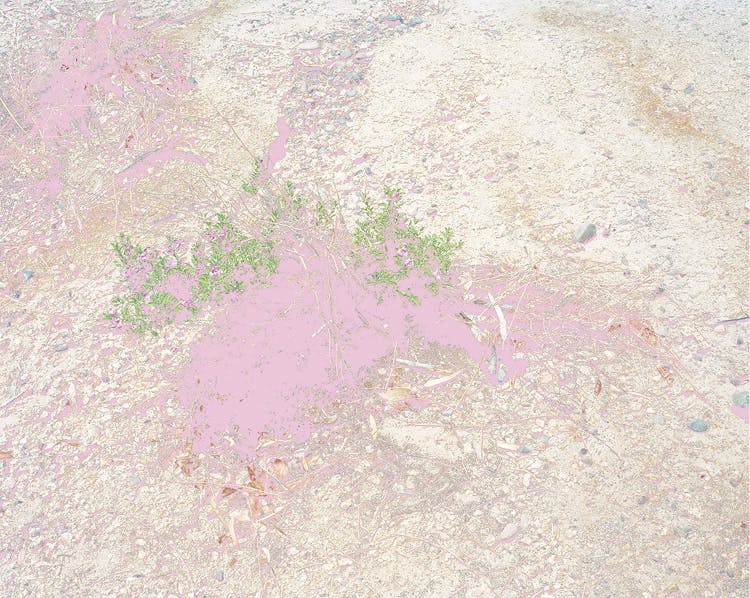
Signal Noise
- Magazine Article
- Exhibitions
Aaron Rothman's transmutive photographic studies take us from rocky landscapes to the Milky Way

Shadow (Pink) 2012. Aaron Rothman (American, b. 1974). Inkjet print; 76.2 x 95.3 cm. Courtesy of the artist and Rick Wester Fine Art, New York
A photograph “takes the world and makes it into something else,” says Aaron Rothman, whose interest lies in transformative rather than documentary photography. This exhibition surveys 10 years of Rothman’s studies of the landscape of the American West, a region with which he has a deep, long-standing personal relationship. Raised in suburban Chicago, he visited California’s Sierra Nevada mountain range each summer while growing up and has spent most of his adult life in Phoenix.
When you visit Transformer Station, don’t expect to see majestic, distant vistas of desert moonrises or sheer rock faces. Rothman instead looks up at the sky and down at scrubland, humbler rocks, and foliage. Through analog and digital photography and digital processing and printing, he transmutes these unpretentious fragments of nature into sensuous, sublimely beautiful images that hover between two- and three-dimensional space and vacillate between representation and abstraction.
The exhibition’s title, Signal Noise, refers to how digitally processed images contain both signal—the content intended for viewers—and noise—visually distracting artifacts caused by the technology. Rothman’s landscapes embrace this duality: content and process, the natural and the artificial. He typically uses a 4 x 5 inch analog (film) view camera and scans the processed negatives to create digital files. Each artwork starts as a straightforward photograph that is taken because of the artist’s connection to a specific place, but “this doesn’t mean that the end results are about communicating that experience,” Rothman says. “A lot happens in the studio after I take the initial photo.”

In the Shadow, Wildflower, and Rocks series, Rothman digitally replaces the naturally shadowed areas in close-ups of plants and rocks with colors unrelated to the place and the experience of viewing it. “When I first came to Arizona, I was immediately taken by the quality of light,” Rothman recalls. “In the prime of summer, it is more of an obliterating than an illuminating force. . . . To express this sensation, I began digitally removing the shadows from my photographs. Pushing this method a little, I started filling in the removed shadow areas with vivid color—an artificial brightness to counter the brightness of the sun.” This bold use of artifice points to the gap between the physical world and our always subjective experience of it.
The Pass and Lightness works combine multiple views of a single site, but in different ways. Each Pass picture combines several shots of a vista at Monitor Pass in the eastern Sierra Nevada, taken years apart, to evoke a dissonance of time and space. As Rothman digitally layers the images, he “can change how the visual data interact to create reversals or amplifications or areas where the images cancel each other out. . . . The pictures are partially about the distancing of memory.” Erasures of parts of the landscape anticipate their possible loss, although no cause of such a disaster is suggested.
The Lightness pieces are all multipanel works. They further underline the shifting nature of perception while emphasizing the unreliability of the camera’s fixed, single-point perspective through subtle disjunctions such as shifting horizon lines and the dematerialization of landscape features. The artist sees these works “as a metaphor for the state of the natural world—a reflection of anxiety for a warming planet.”
Rothman’s images of the sky, all untitled, reverse light and dark. For instance, an early-morning view is darker at the horizon instead of lighter. Lacking indications of time and direction and absent a horizon line, the photos leave us unmoored in time and space, floating in a field of deliciously rich color. Although the sky images may appear simple, they were difficult to produce. Instead of his usual negative film, Rothman used positive transparency film, which offers truer fidelity to actual light conditions. Scanning the processed film also required special care to avoid color shifts, among other problems.

The only images in the exhibition shot digitally are the Milky Way pictures. They meld a macrocosmic view of the galaxy with a microcosmic view of noise from a digital camera’s sensor. Sensor noise—which photographers typically try to minimize—here dominates the signal, or the information being recorded. Using a short enough exposure to capture the stars without recording their movement required the digital sensor’s highest sensitivity setting. The higher the setting, the more likely there will be noise. In the studio, Rothman went further, removing the filters that suppress noise. “I liked how the stars began to dissolve into the noise,” he says, “the thing seen [dissolving] into the method of seeing it.”
“I want the pictures to undermine the idea that there’s some perfect view or a singular vantage point in the world,” Rothman reveals. “All the work occupies these indeterminate, in-between spaces—the blurry boundary between the real and the visual, that gap between the world and how we perceive it, the increasingly hard-to-make distinction between the natural and the artificial.”
Cleveland Art, January/February 2020